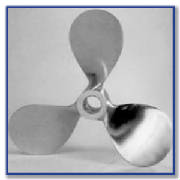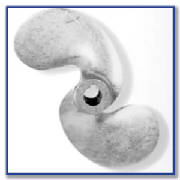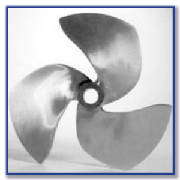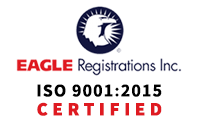Propeller Types and Styles
Investment Casting Propeller Styles
There are a variety of propeller types available for manufacture based on the materials used and the purpose they were built for. Make sure you get the right propeller type for your needs by consulting the information below.
 3-Blade MP Style
3-Blade MP Style
The 3-blade MP style propeller is a multi-purpose propeller designed for mixing, blending, agitating and liquid movement of all kinds. The propeller incorporates a modified semi-elliptical design, which was developed from years of experience and research, and is considered the standard by which propellers are judged. The MP style is available in "full" blade tip for open liquid applications or a "clipped" tip design for improved efficiency in a duct. The MP style is offered standard in a 3-blade design (both super and square pitch) but also available in a 4-blade design for some sizes.
 2-Blade Weedless
2-Blade Weedless
The 2-blade weedless propeller is commonly used on aeration and mixing equipment employed in water and wastewater treatment applications. The weedless propeller was designed by Quality Castings to be utilized in applications where solids and other stringy material may be encountered. The non-fouling design eliminates material build-up on the propeller, mitigating equipment failure. The weedless propeller is available in a "full" blade tip design for open liquid applications, or a "clipped" blade design for improved efficiency in a duct.
 3-Blade Weedless
3-Blade Weedless
The 3-blade weedless propeller is commonly used on aeration and mixing equipment employed in water and wastewater treatment applications. The weedless propeller was designed by Quality Castings to be utilized in applications where solids and other stringy material may be encountered. The non-fouling design eliminates material build-up on the propeller, mitigating equipment failure. The weedless propeller is available in a "full" blade tip design for open liquid applications or a "clipped" blade design for improved efficiency in a duct.
Check out our in-stock cast propellers list for an example of the wide selection available from R2 Quality Castings.
Comparisons Between the Number of Blades
The number of blades on a propeller can drastically determine how well it will perform in specific conditions. Sometimes more is not always better, but in some cases the higher durability will be worth the extra cost for higher blade counts.
2 Blades
- Much lower manufacturing cost than propellers with more blades
- High speed and acceleration
- Difficult handling at low speeds
- High vibrations and noise
3 Blades
- Slightly lower manufacturing costs
- Good speed and acceleration
- Moderate control at lower speeds
- Reduced vibrations and noise
4 Blades
- Higher manufacturing costs
- Lower speed and acceleration
- Better handling at low speeds
- Significantly reduced vibrations and noise
- Good strength and durability
5 Blades
- Much higher manufacturing costs
- Much lower speed and acceleration
- Great handling at low speeds
- Minimal vibrations and noise
- Lower fuel economy and efficiency
Comparisons Between Pitch Types
The pitch of a propeller is the displacement the propeller makes per revolution (360˚). There are 2 main pitch types: fixed and controlled.
Fixed Pitch Propeller (FPP)
- Blades are permanently attached to the hub
- Manufactured through precision casting
- Robust and reliable, no extra moving parts
- Lower manufacturing and installation costs
- Great high-speed performance and acceleration
- Slightly more difficult low-speed handling
Controlled Pitch Propeller (CPP)
- Blades can rotate to change the pitch
- Commonly manufactured from stainless steel and other metals
- Requires complicated mechanical and hydraulic components
- Incredibly high manufacturing and maintenance costs
- Superior handling at low speeds
- High fuel economy and efficiency


